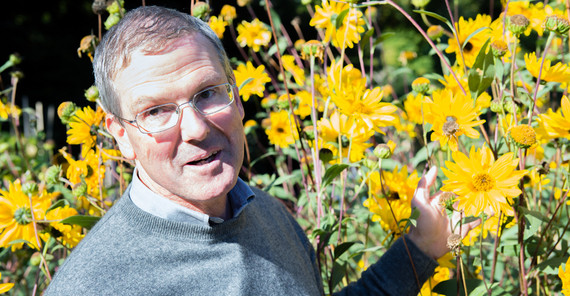Enjoying nature, rejoicing in flowers, trees, and plants is a need for many people. This is why botanical gardens attract so many visitors and are a popular excursion destination. In Germany alone there are about 70. They are also intensively used for horticultural purposes, to cultivate domestic and exotic plants and fruit. Teachers and researchers integrate botanical gardens into their work and so does biologist Dr. Ewald Weber, who sees them as a source of new invasive plants.
Over 50,000 plant species from all over the world are cultivated in German botanical gardens. Most of them are wild plants, varieties not from nurseries or cultivated but capable of surviving in the wild. It is these species that fascinate Ewald Weber from the Institute of Biochemistry and Biology. He is part of a research team doing a global analysis of feral plants, the results of which were recently published in the scientific journal Nature. The researchers collected data on the number of indigenous and feral plants in over 800 countries and islands. “The result was a census on alien plants,” Weber says. The researchers identified over 13,000 plant species growing outside of their natural range, which is about 4% of all known higher plant species.
Impact on Humans and the Environment
Since Europeans arrived in the Americas, plant and animal species have spread on a large scale between the continents. Some of these species took on a life of their own, reproducing without anthropogenic influence in these new territories – they grew wild. Whether deliberately imported ornamental plants from overseas or accidentally introduced insect eggs, new exotic species are appearing all the time. Prominent examples of feral plants in Germany are the Canadian goldenrod and the black cherry, both of which originate in North America. Their excessive reproduction has obvious negative effects on humans and the environment. Biological invasions are considered the second most important reason for the worldwide decline of species. These invaders negatively impact ecosystems, displace other species, and, thus, have to be controlled. Logically, biologists now systematically observe and research such invasive species. Weber examines “whether invasive plants show key characteristics and whether preventive measures are able to stop new biological invasions.” Through comparative ecological examinations, he wants to identify whether invasive and non-invasive species differ with regard to combinations of characteristics like growth rates, competitive capacity, and phenotypic plasticity. This is done mainly through cultivation experiments, in which plants are grown and measured under controlled conditions. Additionally, he examines whether invasive plants can be recognized. His research also uses existing data bases.
Strategy on Biodiversity
Weber was awarded a three-year funding package from the German Federal Environmental Foundation (DBU) for the project “Botanical Gardens as a Source of New Invasive Plants: Risk Assessment and Preventive Measures”. This project falls within the bounds of the “German National Strategy on Biological Diversity” adopted by the Federal Government in 2007. The strategy implements aims and measures laid out by the UN Convention on Biological Diversity. One of the action areas is “biosafety and preventing the adulteration of fauna and flora”, and this exactly where Weber’s project ties in. Weber has been studying neophytes for a long time. He found “that surprisingly a systematic recording of wild plant population has been missing.” This deficit inspired his current project, which started in summer 2015. The goal of the project is to provide information for botanical garden curators, especially for those outdoor plants that grow wild and may cause problems in Germany. A publicly accessible web portal is planned as well. The ultimate aim is to initiate effective preventative measures against new invasive plants growing wild, i.e. to prevent alien species from being introduced into nature.
Preventing Plants from Growing Wild
The Himalayan balsam is a plant that has inhabited the wilderness and is considered invasive. Its original range is the Indian subcontinent, but it was introduced as an ornamental plant in the 19th century in North America and Europe. It has since spread rapidly in Baden-Württemberg and near Dresden, interfering with the growth of rare plant species. The false acacia is another such plant, which originally came from North America. In Europe it was planted in parks and gardens, but has since grown wild.Weber registers all plant species cultivated in botanical gardens. In the resulting lists, he looks for species that have been found elsewhere and have grown wild in countries with a similar climate. Weber hopes to collect as much data as possible. So far he has made 20 lists. The biologist is still working “theoretically” on the computer and not yet on the plants. About 90% of the plants will be excluded during prescreening. It is rather unlikely that high-alpine species from the Himalaya will become feral plants in our region. “Ultimately about 1000 species will remain for thorough examinations,” the researcher says.The expected results will be extremely useful for curators. “If the giant sunflower is identified as an invasive species, for example, useful preventive measures could be introduced like stopping it from spreading seeds or cutting its infructescene.Because new plants are constantly being introduced under changing conditions, feral plants are still unknown. In other words, it is research with a future.
The Researcher
Dr. Ewald Weber studied biology in Basel. Since 2009 he has been research assistant at the Institute of Biology and Biochemistry of the University of Potsdam.ContactUniversität Potsdam Institut für Biochemie und Biologie Maulbeerallee 2a, 14469 Potsdam ewweberuuni-potsdampde
The Project
Botanical Gardens as a Source of New Invasive Plants: Risk Assessment and Preventive MeasuresParticipating: Dr. Ewald Weber, Prof. Jasmin Joshi, Dr. Michael BurkartDuration: June 2015-March 2018Funded by: German Federal Environmental Foundation (DBU)
Text: Dr. Barbara EckardtOnline gestellt: Matthias ZimmermannE-Mail an die Online-Redaktion: onlineredaktionuuni-potsdampde

